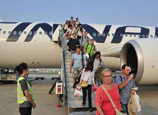
Government officials from the Shennongjia Nature Reserve in Hubei Province have insisted that the area's 2,580-meter-high new airport will not cause serious damage to the local ecosystem.
Dubbed the highest airport in central China, the Shennongjia airport is scheduled to be put into use on October 1 after two years of construction. Building the airport has flattened five 60-meter-high mountains and filled up 217 valleys and karst caves nearby, the Wuhan Evening News reported.
Local officials justified the construction by saying earlier this month that it would shorten the trip to the provincial capital Wuhan from the current nine-hour drive to a 50-minute flight.
As a national 5A-Class Scenic Spot, the reserve boasts rich natural forest resources with more than 5,000 species of animals and plants, and is the only well-preserved sub-tropical forest ecosystem in the world's mid-latitudes.
Although the nearly 1-billion-yuan ($163 million) project is far from the nature reserve and has passed a strict environment assessment, its location still stokes fear among Web users who are concerned about the potential for great environmental damage.
Zhang Yuanxun, professor of resources and environment at the Chinese Academy of Social Sciences, told the Global Times that all the objections and questions were a natural response, considering the lack of credibility of some local officials.
"Such a large construction will bring damage for sure, but it could be limited with high-standard environmental evaluations," Zhang said.
"We built the airport as a scenic spot, and have chosen a location on comparatively flat mountains that bring smallest damage to the surrounding environment. The highway to the airport has also been renovated into a tourist route," said project leader Yin Xiande, Xinmin Evening News reported.
Alongside the construction, protection of the vegetation and environmental restoration are ongoing, said Yin.
A local elementary school teacher surnamed Chen, who offers home stays to tourists in Muyu township near the reserve, told the Global Times that the influence was not as serious as has been reported.
"There are no residents living around, and the airport will do more good than bad since it saves visitors hours on the road," he said.
The environment has the ability to recover and can bounce back from the damage in one or several decades. But the short-term influence is obvious, according to Zhang.
"The highway may cut mountains in half to divide the original habitat where animals can walk freely. The emissions brought by large crowds of passengers may also become a problem," Zhang noted.
















 Developer razes historic Guangzhou structures
Developer razes historic Guangzhou structures


![]()
